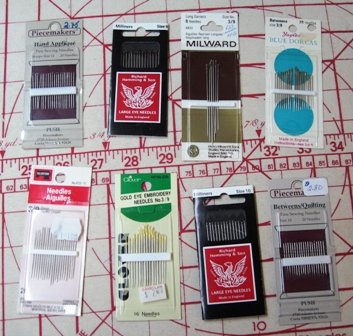- Home
- Needles & Pins
- Sewing Needles
Hand Sewing Needles
You will need a basic selection of hand sewing needles. They come in lots of sizes and types. Choosing the best needle for the job will make your sewing easier. But to get started, all you need are a few basic types of hand sewing needles.
Basic Hand Sewing Needles
For starters, you want the correct size of needle for the job. Needles that are too large are awkward to use. And needles that are too small are difficult to handle. In general, use larger needles, such as #7, #8, or #9, for basting. You can use a larger needle here because basting stitches are usually larger than stitches used for sewing seams together. For hand sewing seams, use a #10, #11, or #12, depending on the fineness of the project.
Sharps: This is the workhorse of hand needles. Use it for most of your hand sewing. As in all hand needles, the higher the size number, the finer and smaller the needle. You can usually buy a card with a selection of sizes. Or if you find you are sewing a lot of similar things in similar fabric, get a card of all one size needle. I usually use a #10 or #11 for most hand sewing.
Betweens (‘tweens) or Quilting: These are shorter versions of sharps. They are useful in quilting because they give more control for going through layers in hand quilting, but are also useful in sewing for fine detail work. Some people prefer using ‘tweens instead of sharps for general sewing. It’s just a matter of preference. They are a bit harder to handle in the very small sizes.
Other Types of Needles
 Hand needles come in different types and sizes. Add as many are useful to your store of needles and pins.
Hand needles come in different types and sizes. Add as many are useful to your store of needles and pins.Crewel needles have a very large eye and a blunt tip. They are usually used for crewel embroidery, but may be useful if you need to sew a decorative thread for trim on your doll clothes.
Tapestry needles are an even bigger version of a crewel needle. They have a very big eye and a much blunter point. They are used for tapestry embroidery work. Again, it is handy to have one around for larger decorative threads you might want to use for embellishments.
Milliners: These are longer, usually finer needles than sharps. As suggested by the name, they were used by milliners for hat making. People also use them for smocking and sewing through multiple layers of fabric. I use them for basting... Yes, basting! Basting is a truly valuable skill for sewing doll clothes—or anywhere else you need fine control. Some things, like zippers, gathering, sleeves and so on, can’t be sewn accurately without basting. Neither can slippery or difficult fabrics be sewn without careful basting! A medium-sized milliner’s needle with help with accurate basting.
These are the basic set of needles you need. In addition,
you’ll need some sort of thimble and a block of beeswax.
Return from Hand Sewing Needles to Needles & Pins -->
Return to Home Page -->